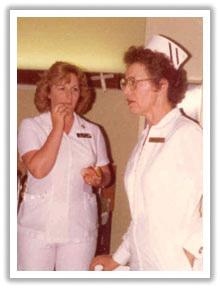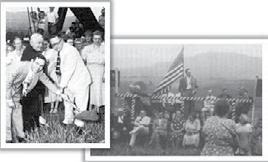
3 minute read
MacKinlay’s vision provides lasting legacy
Editor’s note: This story originally appeared in a special Banking on the future section produced by the FCMC Foundation for the Medical They needed to raise more than $100,000. It became a Center’s 65th birthday celebration in 2015. constant round of meetings – traveling to Harrisburg for I n 1946, Dr. Edgar H. MacKinlay began to confide with friends about his vision for a medical facility – a “small hospital big enough to handle emergencies and maternities” – explaining its importance and the difference it community again for help. A $30,000 mortgage was signed, and a demand note of an additional $25,000 was signed by 15 directors, who were personally liable for its payment. They had faith in the determination of the community. would make between life and death. Meanwhile, an Auxiliary spawned from the Green Hill Civ
It fell on deaf ears to many people and area organizations. ic Club and they went to work with fundraisers – they even There was one group, however, that listened to his plea on had a radio contest. Miss Nell Barmont, RN, wrote an open Oct. 7, 1946: The Green Hill Civic Club. letter to the residents of Fulton County that appeared in the Dr. Edgar H. MacKinlay area newspaper, asking for their support, while reminding Helen DeShong remembered that day them not to take for granted the dedicated services of the “I was sitting in his office as a patient that day,” said Helen DeShong, 96, who passed at age 100 in 2019. “He was so excited about that night physicians who were in the county. Donations began to trickle in more consistently. Soon they had some traction for financing. because he was going to talk about his vision. He asked if I thought we federal and state funds, which weren’t given, to asking the would be able to help. I said I couldn’t make any promises because it was Vision to reality up to the group, but we were willing to listen.” On July 8, a contract for $70,000 was signed to build the structure.
Advertisement
They agreed to consider his plea, and 10 months later, the first Groundbreaking took place on July 16, and the building was dedicated fundraiser – a cake festival – took place, and the first gift was presented: on Sept. 2, 1950, ironically on the last day of Fulton County’s 100th anni$329.22. versary. FCMC opened its doors on Oct. 4, 1950. It was a flicker of hope. MacKinlay convinced his new lawyer friend Albert Foster, who was living in an apartment above his practice, to attend a meeting with him It was done without aid from the state or federal government; it was a Fulton County institution, conceived by Fulton Countians and built by Fulton Countians in the spirit of those who settled in the area. Today, a new facility sits on 90 acres of plush farmland and is the in February 1947 at the Fulton County Courthouse. jewel of Fulton County. It serves our rural community and surrounding
Foster would later say he didn’t know what he was getting himself into areas with over 90,000 patient visits a year. – he would become campaign chair to build the first Medical Center. MacKinlay’s vision has left a lasting legacy. ■
1980s
May 29, 1980: In a study of the center’s operations, MEDCO (Management Effectiveness and Development Consulting Organization) reported to Fulton County commissioners that FCMC was one of the most effective and efficiently run businesses they have come across. June 30, 1980: Dr. James E. Witt, D.O. returned to private practice at 126 N. Second St.
1981
Nov. 18, 1980: FCMC marks 30th anniversary. 1982 1983
Jan. 15, 1983: Skilled nursing room rate was $55 per day.

1984







